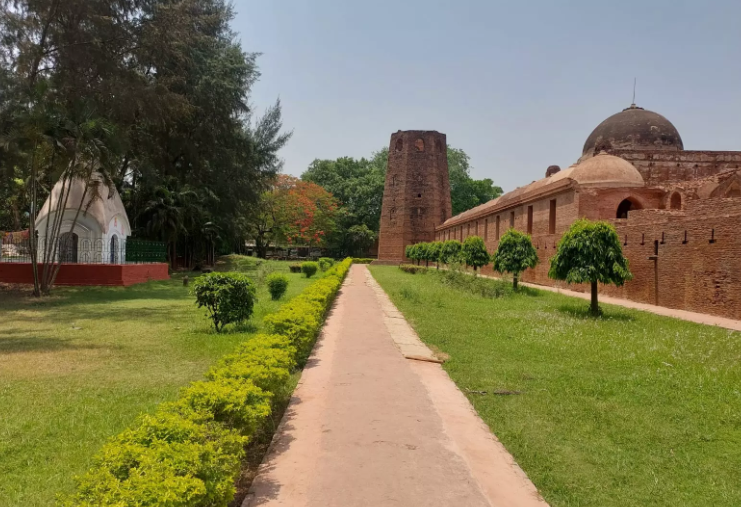Communal amity hangs precariously between hate and harmony in Bengal's Murshidabad
The Hindu-Muslim harmony and plurality that the Bengal district is known for is threatened by recent instances of communal strife including clashes during Ram Navami celebrations;

A Shiva temple inside the premises of a 300-year-old mosque is the kind of pluralism that the former capital of undivided Bengal, Murshidabad, is battling to preserve amidst attempts to divide communities for votes.
Built by the first Nawab of Bengal -- Murshid Quli Khan, after whom Murshidabad is named – the mosque in its campus houses a Shiva temple constructed by the Nawab in the later years of his life as a testimony to his reverence for both the faiths.

An ancient Shiva temple in the complex of Katra Mosque in West Bengal's Murshidabad district where traditional communal harmony faces threats from politicians eager to polarise communities. Photo: The Federal
Hindu-Muslim harmony
Though 'namaz' is no longer offered in the ASI-maintained mosque, 'puja' is performed in the temple which has now been partitioned aside by iron grills.
Some 20 kilometres from Katra mosque lies Kiriteshwari, declared as the best tourism village in India by the central government last year.
The quaint village is another epitome of communal harmony. Apart from the scenic beauty, the village stands out for the unique architectural style of a 300-old temple from which it derived its name.
The red-and-white coloured temple blended Buddhist, Muslim and Hindu architectural styles. True to its multi-religious symbolism, many Muslims serve in the temple committee and actively take part in its rituals.
The Muslim majority district is dotted with similar examples of religious co-existence.
Mahendrapur is another sleepy hamlet typified by its pluralistic character. For the past 15 odd years, Muslim residents of the village have taken up the responsibilities of organising the village’s annual Kali puja-cum-fair as most of their Hindu neighbours have moved out to urban centres for better livelihood.
Plurality under attack
The plurality manifested in the district is microcosmic of Bengal’s long-tradition of communal amity, which is now under attack from Hindu nationalists.
Violence broke out during this year’s Ram Navami celebrations in the Shaktipur area of Murshidabad in which a woman was injured.
The Ram Navami incident was the outcome of the simmering communal tension in the Beldanga block of the district for a few months that largely went unreported.
“First, some miscreants disrupted a Muslim social function at Kamnagar, where Hindus are the majority. A few days later a Hindu religious congregation was attacked in Muslim-majority Mirzapur village,” said Alamgir Hossain, a veteran journalist and political commentator from the district.
Many local residents – Hindus and Muslims alike – say the Kamnagar incident, which was the trigger point for the subsequent violence in Mirzapur and Shaktipur was staged to polarise Hindu votes.
Most voters in the block that falls in the Berhampore Lok Sabha constituency were supporters of West Bengal Pradesh Congress president Adhir Ranjan Chowdhury, who has been winning the seat since 1999.
“Communal tensions are fanned to polarise voters,” said a Hindu resident from Mirzapur who preferred anonymity.
Significantly, the Uttar Pradesh chief minister and a BJP star campaigner, Yogi Adityanath, who is known for his polarising rhetoric, campaigned in the violent-hit Shaktipur on April 30.
Singling out a particular community for the Ram Navami violence, Adityanath said his government would have hanged the perpetrators upside down if such an incident had happened in Uttar Pradesh.
The tone and tenure of his entire speech was provocative.
Sudden rise in Ram Navami events
“Keeping in mind the demographic profile of the district, the BJP is trying to incite communal hatred in a bid to create a bipolar polity,” Chowdhury told The Federal.
Murshidabad has the highest concentration of Muslim population among all the districts in West Bengal. This makes it a potential target of Hindu-victimhood narrative.
"Driving a wedge between Hindus and Muslims is a long-term project of the BJP-RSS in the district," added another Congress leader from the district, Manoj Chakraborty.
That their statements were not mere political accusations become evident from the ever-increasing number of sword-wielding menacing processions being taken out in the district during Ram Navami since 2014.
The number of their 'shakhas' more than doubled in the district's Berhampore, Jiaganj-Azimganj, Sagardighi and Beldanga areas in the last 10 years, claimed local RSS sources.
Communal harmony at stake
True to the district’s long secular tradition, many Muslims do take part in some Ram Navami celebrations and Hindus in Eid festivals. But beneath the veneer of amity, a sense of enmity and suspicion is also creeping in, Hossain observed.
This was best illustrated by a recent incident wherein a promoter was reportedly forced to cancel flat bookings of a group of Muslim persons at Gora Bazar area of Berhampore following pressure by the neighbourhood.
Two doctors and a professor were among those whose bookings were cancelled.
Rural areas still untouched
The silver-lining is that prejudice has not seeped into society's core, particularly in rural areas, Hossain pointed out.
Babul Roy, a social activist from K K Banerjee Road area of Berhampore, seconded the contention, claiming that the communal tension over the Ram Navami-day violence fortunately did not spread beyond certain pockets of Beldanga blocks.
That this time there is no overriding communal plank to raise the bogey of victimhood came as a welcome relief, he added.
The old tradition of harmonious co-existence can be preserved only if the politicians do not try to vitiate the atmosphere, Roy said. But that is a tall order.
The district has three parliamentary constituencies – Murshidabad, Jangipur and Berhampore. The first two will vote on May 7 while polling in Berhampore is scheduled for May 13.